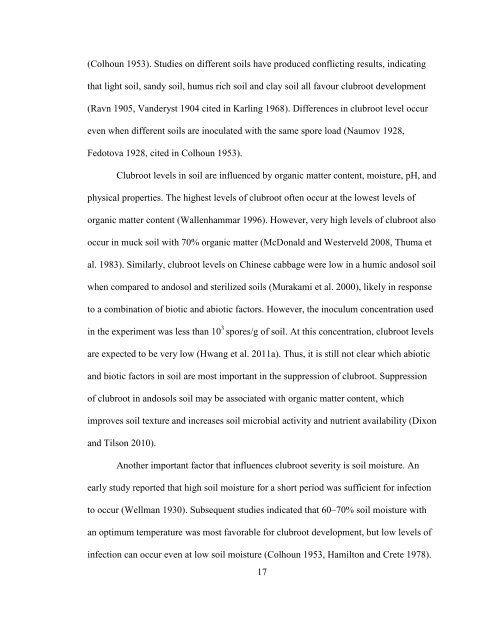Hema Kasinathan Thesis May 1 2012.pdf - Atrium - University of ...
Hema Kasinathan Thesis May 1 2012.pdf - Atrium - University of ...
Hema Kasinathan Thesis May 1 2012.pdf - Atrium - University of ...
You also want an ePaper? Increase the reach of your titles
YUMPU automatically turns print PDFs into web optimized ePapers that Google loves.
(Colhoun 1953). Studies on different soils have produced conflicting results, indicatingthat light soil, sandy soil, humus rich soil and clay soil all favour clubroot development(Ravn 1905, Vanderyst 1904 cited in Karling 1968). Differences in clubroot level occureven when different soils are inoculated with the same spore load (Naumov 1928,Fedotova 1928, cited in Colhoun 1953).Clubroot levels in soil are influenced by organic matter content, moisture, pH, andphysical properties. The highest levels <strong>of</strong> clubroot <strong>of</strong>ten occur at the lowest levels <strong>of</strong>organic matter content (Wallenhammar 1996). However, very high levels <strong>of</strong> clubroot alsooccur in muck soil with 70% organic matter (McDonald and Westerveld 2008, Thuma etal. 1983). Similarly, clubroot levels on Chinese cabbage were low in a humic andosol soilwhen compared to andosol and sterilized soils (Murakami et al. 2000), likely in responseto a combination <strong>of</strong> biotic and abiotic factors. However, the inoculum concentration usedin the experiment was less than 10 3 spores/g <strong>of</strong> soil. At this concentration, clubroot levelsare expected to be very low (Hwang et al. 2011a). Thus, it is still not clear which abioticand biotic factors in soil are most important in the suppression <strong>of</strong> clubroot. Suppression<strong>of</strong> clubroot in andosols soil may be associated with organic matter content, whichimproves soil texture and increases soil microbial activity and nutrient availability (Dixonand Tilson 2010).Another important factor that influences clubroot severity is soil moisture. Anearly study reported that high soil moisture for a short period was sufficient for infectionto occur (Wellman 1930). Subsequent studies indicated that 60–70% soil moisture withan optimum temperature was most favorable for clubroot development, but low levels <strong>of</strong>infection can occur even at low soil moisture (Colhoun 1953, Hamilton and Crete 1978).17
















